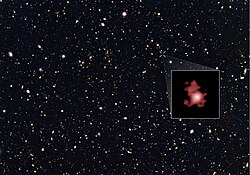| GN-z11 | |
|---|---|
 GN-z11 superimposed on an image from the GOODS-North survey | |
| Observation data (J2000 [1] epoch) | |
| Constellation | Ursa Major [1] |
| Right ascension | 12h 36m 25.46s [1] |
| Declination | +62° 14′ 31.4″ [1] |
| Redshift | 10.6034±0.0013 [2] |
| Heliocentric radial velocity | 295,050 ± 119,917 km/s (183,336 ± 74,513 mi/s) [3] |
| Distance |
|
| Apparent magnitude (V) | 25.8H |
| Characteristics | |
| Type | Irregular |
| Mass | ~1×109 [4] M☉ |
| Size | 4,000 ± 2,000 ly (1,200 ± 610 pc) [4] |
| Apparent size (V) | 0.6arcsec [4] |
| Other designations | |
| GN-z10-1, [4] GNS-JD2 [3] | |
GN-z11 is a high-redshift galaxy discovered by NASA's Hubble Space Telescope in the constellation Ursa Major. It is among the farthest galaxies from Earth ever found. [5] [6] [7] The 2015 discovery was published in a 2016 paper headed by Pascal Oesch and Gabriel Brammer (Cosmic Dawn Center). Up until the discovery of JADES-GS-z13-0 in 2022 by the James Webb Space Telescope, GN-z11 was the oldest and most distant galaxy yet identified in the observable universe, [8] having a spectroscopic redshift of z = 10.957, which corresponds to a proper distance of approximately 32 billion light-years (9.8 billion parsecs ). [9] [note 1] Data published in 2024 established that the galaxy contains the most distant, and therefore earliest, black hole known in the universe, [10] [11] estimated at around 1.6 million solar masses. [12]
Contents
The object's name is derived from its location in the GOODS-North field of galaxies and its high cosmological redshift number (GN + z11). [13] It is observed as it existed 13.4 billion years ago, just 400 million years after the Big Bang; [4] [14] [15] as a result, its distance is sometimes inappropriately [16] reported without qualification as 13.4 billion light-years, its light-travel distance measurement. [17] [18]
In early 2023, the James Webb Space Telescope observed the galaxy and reported a definitive redshift of z = 10.6034 ± 0.0013. [2]
The galaxy has such a high redshift that its angular diameter distance is actually less than that of some galaxies with lower redshift. This means that the ratio of its angular size (how big it appears in the sky) to its size in light-years is greater.



